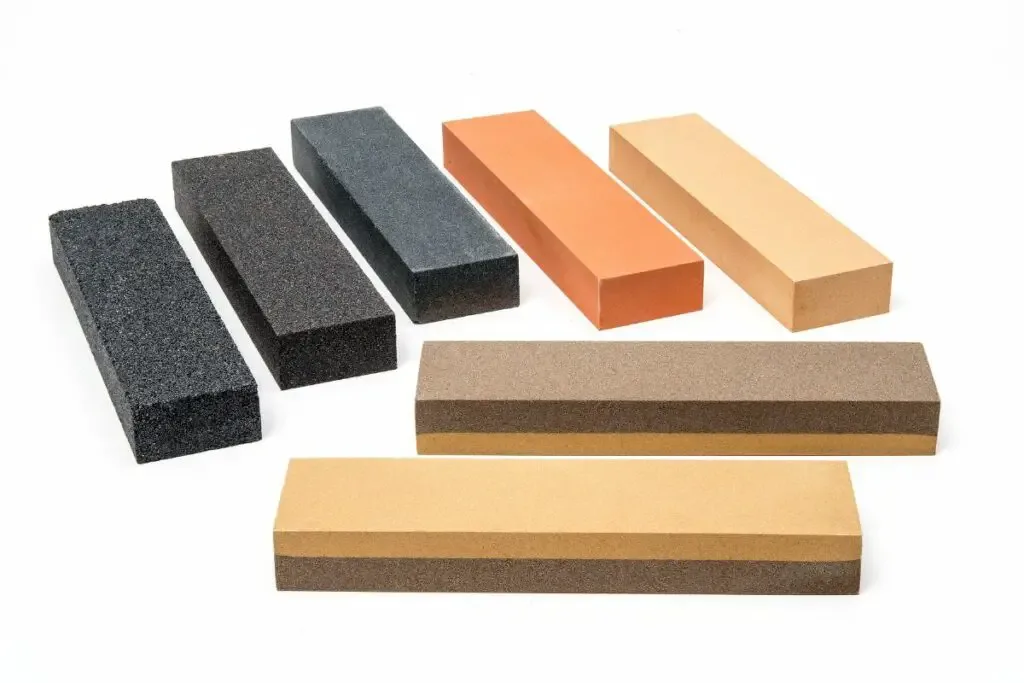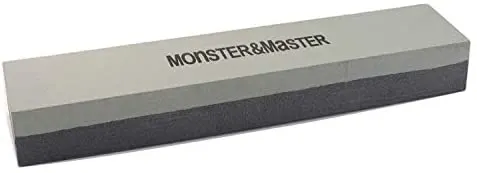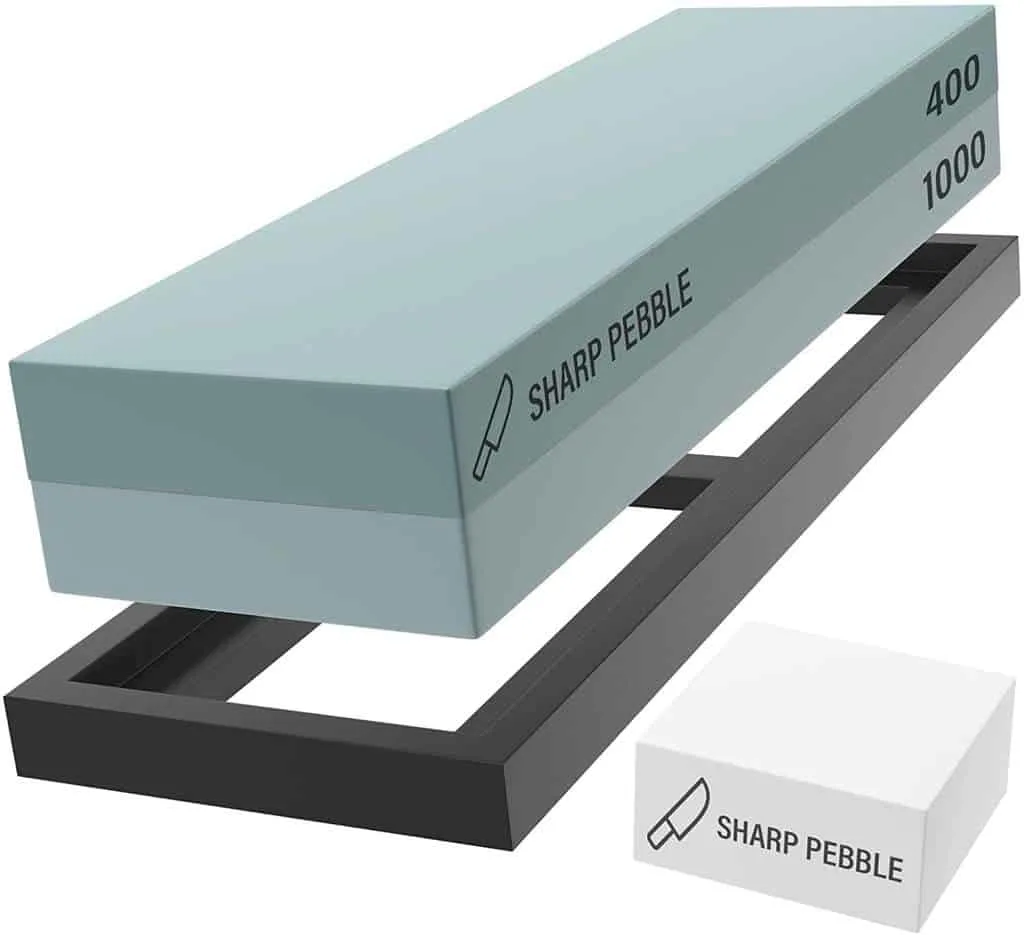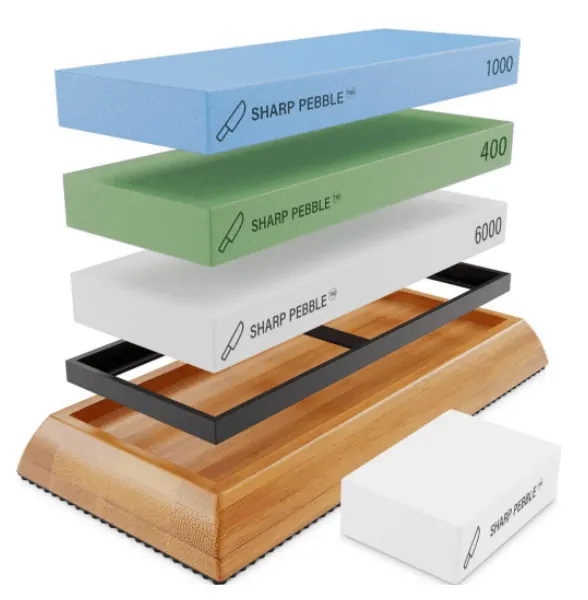As an Amazon Associate, we earn from qualifying purchases with no additional costs for you.
Whetstones come in many different types when it comes to the grit level, the quality of the stone, and the cost of the stone. The cost of these stones can become quite high, which gives a person who is new to knife sharpening a dilemma as to selecting the right stones for getting started sharpening their knives on using this method. So how do you choose the best whetstone for your sharpening and your budget?
When choosing whetstones, you need to balance cost, quality, and the number of stones and grits to maximize the efficiency of sharpening knives with this method. The recommendation is a fixing stone of 120-grit, a combination sharpening stone of 400/1000-grit, and a polishing stone of 6000-grit.
The cost and quality of the whetstones that you buy will often determine the success of your efforts when learning how to sharpen knives with this method.
Going too cheap for lower quality stones may take longer to achieve a good edge, if you manage at all, and could even ruin the edge of the knife completely. Balancing the quality of the stone with the cost and selecting the right grit progression is key when buying your whetstones.
If you are interested in checking out the best whetstones for your knives we recommend and use you can find them by clicking here (Amazon link).
What To Look For When Buying A Whetstone

There are many considerations to take into account when looking to buy whetstones for sharpening your knives. The process is not as simple as picking out the cheapest one, and then you are good to go.
Buying a whetstone or indeed a set of sharpening stones requires investigation and planning to get the right type of stone for your sharpening needs.
The main factors that you will need to consider will include the following.
- What type of whetstones should you get?
- How many whetstones do you need?
- What grit stones do you need?
- What is your budget for the whetstones?
What Type Of Whetstones To Use?
Whetstones come in many different types, from synthetic stones to natural stones and even diamond and glass stones.
You also need to choose whether to use dedicated water stones or oil stones, silicon carbide stones, aluminum oxide stones, or natural stones.
Oil Stones or Water Stones
Essentially, the choice of whether you choose oil over water stones is a personal choice. In fact, with some manufacturers, you can use either water or oil on the same stone, but once you choose the lubrication medium, you need to stick with it.
This, if you start using oil on your stones, you cannot change your mind and then start using water on the stones, and vice versa.
Some stones are designated as oilstones only and some as water stones only, and if the manufacturer indicates what type of lubricant you should be using on the stone, then you should follow the instructions and use the indicated lubricant. Failure to use the recommended lubricant could result in the stone being ruined.
My personal preference is for a water stone since the process is a lot less messy, and the cleanup afterward is much easier than with oil.
However, the results from water and oil on the appropriate stone achieve pretty much the same results, so the choice of lubricant can be left up to you. Your choice is unlikely to produce a poor outcome unless the wrong lubricant is used on the stone.
Oil stones also generally require a specially formulated honing oil to get the best out of the stones. Some people use various household oils, but these can clog up the stones in the long run. Vegetable oils should never be used on an oil stone. These oils break down quickly and form a sticky mess on the stone.
Water stones are less messy and less fussy, and you don’t have to purchase a special lubricant. Any water will do for the purpose of sharpening your knives.
The reason that some people choose to go the oil route over the water route is for sharpening high carbon steel blades that are more prone to rust when exposed to water.
But if you clean your knife off after sharpening it on a water stone and give it a light coat of mineral oil, you should not have any rust problems.
What Type Of Whetstones?

The easiest way to summarize the types of whetstones is to place them in a table where you can see the benefits side by side, which will help you to choose the type of material you prefer for your whetstones.
| Type Of Stone | Advantages | Disadvantages |
|---|---|---|
| Silicon carbide | – Very hard stone – Cuts effectively – Long-lasting – Generally cheaper – Oil or water can be used on these stones but generally, water is recommended. | – Very brittle, the stones can chip and crack more easily – They are harder on the knives and remove more metal |
| Aluminum oxide | – Softer stone – Stone is less likely to chip or crack – Less harsh on the blade – Easier sharpening experience | – Less durable – Wear down faster – Only water should be used on these stones – More expensive than silicon carbide |
| Natural stone (Japanese Waterstones) | – Wide range of grits available – Put a very fine edge on the knife – Less harsh on the blade than other stones | – Extremely expensive – Experienced technique required to use these stones – Stones can be ruined by incorrect use – Only water should be used on these stones |
| Diamond Stones | – Very efficient and even cutting – Stones last a long time – Stones can be used dry or with water – Create a very smooth, even finish – AffordableWon’t chip or crack | – Not as wide a grit range available – Blank spots can be worn on the stones by incorrect sharpening |
Glass stones tend to be extremely expensive and are generally thought of as mostly finishing stones rather than sharpening stones, which is why we have left them out of the table.
How Many Whetstones Do You Need?
The question of quantity will mostly be determined by how you sharpen your knives and to what sharpness level you want to take your knives.
The number of stones required will also depend on how badly damaged the knife edge is and the method and level to which you finish your knives when you sharpen them.
To repair a knife with a damaged edge, you will need a low grit stone to quickly cut away the damaged sections and re-establish the knife edge.
When it comes to finishing the edge, you may want to use a leather strop as the final finish, in which case you will not need a finishing stone.
If, on the other hand, you prefer to finish your knives on the stones, then a high grit finishing stone will be required.
Many whetstones come with two different grits back to back on the stone, which means you can get two stones for the price of one.
At the very minimum, you would need at least two whetstones to sharpen your knives or one stone that has two different grits back to back.
If you need a stone that can repair an edge, then you will need a low grit-rated stone as well. This will take your stone count up to 3 stones.
If you intend to finish the sharpening on stones, then the minimum number of whetstones would be 4 stones. These would be stones in the following categories.
- 1 fixing stone
- 1 coarse grit sharpening whetstone
- 1 fine grit sharpening stone
- 1 finishing or polishing stone
TIP: Are you looking to buy a new whetstone? Check out our recommendations (we personally use the first three ones):
Our PRO choice whetstones combo (Amazon links):
- Fixing stone: Whetstone SHAPTON Ceramic KUROMAKU #320
- Sharpening stone: Suehiro CERAX soaking whetstone: Medium #1000
- Finishing stone: Whetstone SHAPTON Ceramic KUROMAKU #5000
Our budget choice (Amazon link): Sharp Pebble Extra Large Sharpening Stone Set
What Grit Whetstones Do You Need?
There are basically three categories of stones with regards to the levels of grit, and each category performs a different function within the sharpening process.
The three categories of stones are fixing stones, sharpening stones, and polishing stones. We will discuss each of these categories and give our recommendations of grits in each category.
Fixing Whetstones Grits
Fixing stones remove a lot of metal from the blade very quickly, so a broken or damaged edge can be quickly repaired. These stones, however, will not give you a sharp edge on your knife. They do a good job at repairing an edge but not sharpening.
You only need to use these stones if your knife is in a very bad way and needs extensive repair done to the edge. These stones would not be used in regular knife sharpening.
The stones that fall into the fixing whetstone category are stones that are up to the 320-grit level. It is recommended that you do not spend a lot of money on a low grit fixing stone and rather get one that is as cheap as possible.
For the purpose of fixing the edge of a damaged knife, we would recommend a 120-grit silicon carbide stone.
Our budget choice: Monster & Master 120/320 Combination Stone

For a fixing stone, we would recommend this product which comes with the 120-grit and 320-grit back to back, which gives you a coarse fixing stone as well as a finer fixing stone in one package.
This stone will allow you to repair the most damaged knife edges quickly and effectively. This stone is intended to be used with water only; simply soak the stone in water for about 5 to 10-minutes before using it.
If you want to see the current prices for Monster & Master Knife Sharpening Stone 320/120 Grit you can find them by clicking here (Amazon link).
Our PRO choice: Whetstone SHAPTON Ceramic KUROMAKU #320
We personally use Shapton Ceramic Kuromaku 320 as a fixing stone. This Japanese ceramic whetstone is a bit more expensive but it offers you the best quality you can get.
It is suitable for all kinds of steel up to 62-64 HRC and it has long durability as well. If you are planning to do repairs on your knives more often, we recommend buying this whetstone.
If you want to see the current prices for SHAPTON Ceramic KUROMAKU #320 you can find them by clicking here (Amazon link).
Sharpening Whetstone Grits
Sharpening whetstones are the stones that you would use to re-establish a sharp edge on a knife blade. These stones would be used after a blade has been fixed on a 120-grit stone or on a blade that does not need to be fixed but needs sharpening.
These are probably the stones that you would use most frequently out of your entire whetstone collection, and for this reason, we recommend that you get a quality set of stones in this grit range.
You can purchase stones of individual grits, but the dual stones with different grits back to back on one stone are more cost-effectively priced than purchasing individual stones.
The grit category for sharpening stones would be stones that are in the grit range of 400-grit to 3000-grit. In this category, we would recommend at least two stones; one in the lower grit range and one in the medium grit range.
We do not be recommended that you spend money on the higher grit sharpening stones since they would be less effective at sharpening and are moving more into the polishing range of stones.
For this reason, we recommend a combination stone that is 400-grit on one side and 1000-grit on the flip-side of the stone.
Our recommendation as a beginner knife sharpener is to stay with silicon carbide stones until you have mastered the techniques and then move on to more expensive aluminum oxide stones. This premium set from Sharp Pebble is our recommendation for a good quality stone in this category.
Our budget choice: Sharp Pebble Premium 400/1000 Grit Whetstone

Sharp Pebble is a well-known brand name in the whetstone industry and is the first choice for many people who sharpen their own knives.
This 400/1000-grit combo stone is the ideal combination of sharpening stones and will get your knives back to being smooth and sharp.
The 400-grit stone will be used to re-shape the edge to the proper geometry, and the 1000-grit stone will refine the edge and restore the knife to a high level of sharpness.
The package comes with a non-slip stand for the stones and a re-surfacing stone to flatten your Sharp Pebble stones once they start to wear.
If you want to see the current prices for Sharp Pebble Premium 400/1000 Grit Whetstone you can find them by clicking here (Amazon link).
Our PRO choice: Suehiro CERAX soaking whetstone: Medium #1000
We personally use this whetstone for re-establishing a sharp edge and basic sharpening on a knife blade. Suehiro CERAX whetstone comes with 1000 grit and it belongs to classic and one of the most favorite synthetic Japanese whetstones for a reason.
The main highlights of CERAX are top Japanese quality, nice and smooth feedback, and it works well on the most kind of steel.
If you want to see the current prices for Suehiro CERAX soaking whetstone – Medium #1000 you can find them by clicking here (Amazon link).
TIP: Are you interested in buying a whetstone? You can find the cheap ones and the expensive ones too. Find out the difference between cheap and expensive whetstones in the article below:
5 Reasons Why Expensive Whetstone Is Better Than Cheap One
Polishing Whetstone Grits
Polishing stones are the higher grit stones. These stones are not efficient in removing enough material to be considered sharpening stones.
They will, however, smooth and polish the sharp edge to enable the edge to cut more easily through objects.
The whetstones that fall into this polishing category are stones that are of 4000-grit and above. The higher the grit number of the stone, the more the edge will be polished to a mirror finish.
Stones that are between 4000 and 6000-grit will give you a low to a medium mirror finish on the edge. Stones that are in the 8000-grit to 12 000-grit range will give you a fine mirror finish on the sharp edge.
You can get polishing or finishing stones that go all the way up to 20 000 and 30 000-grit, but these generally overkill for most people’s purposes.
Stones that are 12 000-grit and above are also normally ridiculously high in price, and the value that they bring to the edge of the knife is generally worth the money. They may make the knife look very pretty, but they add very little to the sharpness of the blade.
For the purposes of polishing to a good quality finish, we would recommend opting for a whetstone that is in the 4000 to 6000-grit range. A stone in this range will give you the best value for money while still putting a very good polish on the sharp edge of the knife.
One of the best ways to get a good quality polishing or finishing stone is to purchase a kit that includes 400/1000-grit stones for sharpening and a 6000-grit stone for putting a medium polish on the edge of the knife.
We can highly recommend the following combination whetstone set from Sharp Pebble that includes all three of these stones.
Our budget choice: Sharp Pebble Extra Large Sharpening Stone Set

This set from Sharp Pebble will give you the ability to take any knife from dull to razor-sharp with the combination of stones that are included in the package.
The 400-grit stone can be used to set the geometry of the knife edge, the 1000-grit can be used to refine the edge, and the 6000-grit stone will put a medium mirror finishing on the edge.
This set of whetstones will meet the sharpening needs of most people, from sharpening kitchen knives of all descriptions to outdoor bushcraft-style knives and pocket knives.
All the stones in this set are designed to be used with water. The set comes with a wood base, a non-slip silicone mat, and a flattening stone.
If you want to see the current prices for Sharp Pebble Extra Large Sharpening Stone Set you can find them by clicking here (Amazon link).
Our TOP choice: Whetstone SHAPTON Ceramic KUROMAKU #5000
SHAPTON Ceramic KUROMAKU grit 5000 is another Japanese whetstone that we really like and regularly use when we are finishing our knives in the sharpening process .
It is suitable for all kinds of steel up to 62-64 HRC and it let a nice aggressive finish on your edge, which suits very well especially for all chef kitchen knives. The mirror finish which this whetstone leaves on your edge is really cool.
SHAPTON KUROMAKU #5000 is a hard whetstone with long durability and there is practically no need to flatten this whetstone.
So if you want to get the best quality for a bit higher price, you will make no mistake by choosing SHAPTON Ceramic KUROMAKU #5000.
If you want to see the current prices for Whetstone SHAPTON Ceramic KUROMAKU #5000 you can find them by clicking here (Amazon link).
TIP: Professional sharpeners do a stropping with leather as a final step when sharpening their knives. Find out a complete guide about stropping in the article below:
How To Sharpen Knives With Leather: A DIY Guide
What Is Your Budget For Whetstones?
You need to carefully consider the budget that you have available for whetstones and then select the grits and quality of stones that are going to give you the most effective sharpening system for the best price.
It is entirely possible to blow your entire whetstone budget on a single ultra-high grit polishing stone, but this may not be a prudent use of your money since a high grit stone like this may add aesthetic value to the sharp edge but will not make the knife cut any better.
When we start a new venture or activity, we tend to want to buy the best there is when we get started. Whetstones are one area where this strategy should not apply.
When you are a beginner, your poor technique while you are learning could easily ruin an expensive stone.
Thus, we recommend going with a more modestly priced set of whetstones until you have advanced your technique enough to the point where more expensive stones can actually add value to your sharpening.
Choosing And Buying A Whetstone FAQ
The following FAQs may be useful to you when you consider the type of whetstone to buy for your knife and tool sharpening requirements.
1. What is the ideal grit for a beginner? For beginners, a medium grit whetstone (around 1000 grit) is a good starting point. It provides a good balance between sharpening speed and the quality of the edge it produces.
2. How often should I replace my whetstone? The frequency of replacing your whetstone depends on how often you use it and how well you maintain it. With regular use and proper care, a good quality whetstone can last for several years.
3. Can I use the same whetstone for different types of knives? Yes, you can use the same whetstone for different types of knives. However, the grit you choose will depend on the condition and type of the knife. For example, a dull knife may require a lower grit for reshaping the edge, while a knife that is already fairly sharp may only need a higher grit for refining the edge.
4. Can I use oil on any type of whetstone? No, not all whetstones are designed to be used with oil. Silicon carbide stones can be used with oil or water, while aluminum oxide stones and natural stones should only be used with water. Always check the manufacturer’s instructions before using oil on a whetstone.
5. What is the difference between synthetic and natural whetstones? Synthetic whetstones, like silicon carbide and aluminum oxide stones, are man-made and have a consistent grit size. They are generally more affordable and widely available. Natural whetstones are naturally occurring stones and can provide a very fine edge. However, they are usually more expensive and require more skill to use effectively.
Conclusion
When you are sharpening a knife on whetstones, there is no need to get one of every grit of stone or of every type of stone.
The process of learning to sharpen on these stones will take time, and for this, you will need a more robust stone that is a little more forgiving while you get your technique right.
We, therefore, recommend a set of stones that include a fixing stone, two grits of sharpening stones, and a single polishing or finishing grit stone.
These would be a 120-grit or a 140-grit stone as fixing stones, a 400/1000-grit combination stone for sharpening, and finally, a 6000-grit stone for polishing and finishing off the edge.
This set of stones will give you a solid whetstone sharpening platform, not only as a beginner but also for more experienced people who have mastered the skills needed to put a great edge on a knife with whetstones.
TIP: Do you know what knife steels are the easiest to sharpen? Check them out in the article below:
List of The Easiest Knife Steels To Sharpen (With Examples)
